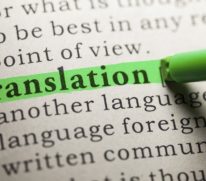The recipe from an Arabic cookbook had a deadly serious ring “Fry onions till golden brown. Soak bread rolls in hot milk, then rest in peace for 30 minutes. This will not be the last time you prepare this dish.”
It’s a translation of course. Humorous, witty, incisive. Exactly the type of translation you hope will never grace the inside cover of your company report when you hand it over in the Middle East.
The art of translation, the poor cousin to creative writing and dashing graphic design, is finally coming into its own. Long gone are the days of delegating translations to the dim-sim stand in Chinatown – or waiting until the world at large speaks English.
With almost one in four Australian residents born outside Australia, individuals and companies alike are going bilingual, by crikey. “I’m flying to Beijing on Friday,” one chief executive pants down the phone. “I need a couple of business cards translated – oh, and our company brochure. I need it in three days…”
Non,nyet, nein. No way!
Contrary to popular belief, translation work is not the automatic process that has translators, trapped inside piles of dictionaries, pressing a button and spouting information in logical sequence.
Translations need time – for ruminating, researching the net, ringing up clients to crack the code of the industry in question. If a document takes a week to create, its smart to give multilingual translators a reasonable time to create the translated version.
Those keen on having their magnum opus reborn for foreign markets can help the translation process enormously – by making sure their English doesn’t need translating into English. “Down Under is over-the top for fun!” claims one advertisement for the Sunshine Coast. “Shake your billy and rattle on down to the house on the hill”, urges another tourist promotion for Australia’s Parliament House. Now, how will all this wash in Bahasa Malay?
One of the first questions to ask when dipping into foreign tongues is, “Where will the material be used?” The Spanish spoken in Argentina, por ejemplo, differs slightly from that spoken in the south of Spain. Targeting the Chinese-speaking countries is even trickier. In mainland China and Singapore, written Simplified Chinese is the go, while Taiwan and Hong Kong stay with the Traditional form. Mercifully all Chinese readers understand the Traditional form, though not everyone follows the Simple. Simple, see?
“I want this document fed to every businessman in Tokyo,” says one enterprising salesman looking to translation to bridge the gap. It couldn’t work in Japan. Because of the hierarchical nature of the language, translators have to nail their clients down to specifics. Who exactly will be reading the material? Is it geared for the local cherry vendor or the vice-president of the Rising Rice Corporation? Striking a rung or two in the wrong direction could mean empty bowls all round.
In an era where English is numero uno, where languages like French have coined the term Franglais for Anglo-Saxon interlopers, the question is – when or when not to translate? This applies particularly to business cards, advertising material and highly technical documents. In many countries today, the use of English on anything from T-shirts to shop displays is considered trendy and exotic. So too the appearance of a company name, a jingle or slogan in the vernacular. Any English term in fact which is universally understood.
In what other language could “jogging”, “weekend” and Big Mac be so smartly summarised? In some cases, where the translated explanation of a simple term is complicated and the English is acceptable – auf Englisch, bitte! Imagine the agony of one Norwegian translator who came up with “elongated macaroni product” for “noodles”.
Strangely the shortest translations are often the toughest. A doctoral thesis on the oscilloscopic properties of the long-horned beetle, for example, has nothing on the humble No Standing sign. A lack of background information has much to do with the problems of translating copy that floats out of context. One translator had high hopes when transforming into Thai an advertisement for “a smoke-free restaurant” – “in this restaurant you can smoke anything you want to”!
It comes as a surprise to many that documents once translated look different from the English. A business letter in English may shrink drastically in Simplified Chinese or expand by 15 per cent in Vietnamese. The German will yawn across the page with doppelgänger words within words causing typesetters to quiver over their keyboards for a word break.
One graphic designer rings in a spin. “Why doesn’t the Japanese setting match the English? Why don’t all the paragraphs begin with the company name as they do in the original?” Translation involves a lot more than mulling over meaning. Style, tone and approach affect the target language and, if the copy is to sing an authentic song, word order changes. So the designer insists on unjustifying the Japanese characters born to line up. It’s possible. It’s hara-kiri.
The key to nirvana and the perfect translation is knowing where the piece is going, the identity of the target audience, the style required and that there are a fair number of hours to complete the process. It all boils down to preparation – the translator’s and the client’s.


